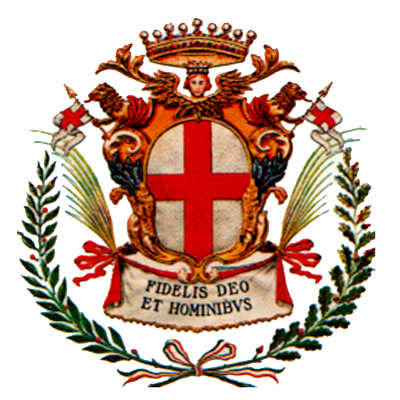Church of San Filippo Neri
Construction of the building, commissioned by
the fathers of the Oratory of Saint Philip Neri, commenced in 1692
to plans by Father Giovanni Domenico Perardi. The church, blessed
and officiated in 1697, was closed during the Napoleonic
domination, reopened and then closed again when the Rattazzi Law
for the suppression of religious orders was enacted in 1855.
On 22 September 1901 the church was redeemed and opened to the
faithful by the canon Monsignor Giovanni Allasia (to whom a
tempietto and burial place inside are dedicated) as a place of
study for the young people of Savigliano and a devotional site for
Virgin of the Rosary, proclaimed queen of Savigliano ? crowned
three times (in 1653, 1903 and 1953) ? and the city's main
patron.
The façade, made of carved terracotta with two registers
surmounted by pilaster strips, ends with a shaped cornice. The
pediment is composed of a triangular top moulding and two large
shell-shaped volutes.
The old fresco in the middle over the portal depicts Saint Philip
with the Virgin, Child and Angels. A tablet on the left of the
façade evokes Saint Dominic's visit to Savigliano and the
sermon of the rosary.
The interior of the building presents a nave with Florentine
terracotta flooring and two side altars. The one on the right has a
canvas depicting Our Lady of the Rosary, from the former convent of
San Domenico. Painted by Jean Claret in 1636, the work was
commissioned by the local administration in gratitude for the
salvation from the plague that had decimated the town. The left
altar is adorned with the Virgin and Child with Saint Philip Neri
and Blessed Sebastian Valfré, a canvas painted by Domenico
Cardellino in 1839.
On the wall to the right of the high altar there is a fresco
painted by Luigi Morgari in 1907, describing the two coronations ?
in 1653 and 1903 ? of the Virgin of the Rosary, the patroness and
queen of Savigliano.
Lastly, valuable works can be seen in the sacristy, such as Our
Lady of Mount Carmel and Saints Simon Stock, Theresa of Avila,
Charles Borromeo, Scholastica and the Souls in Purgatory, by the
famous seventeenth-century painter Giovanni Antonio Molineri.
The cloister annexed to the church, built in 1730 to plans by the
architect Francesco Gallo and completed in 1770 by Filippo Amedeo
Turletti, was extensively restructured in the following centuries
and is now used in part by the local elementary school.

